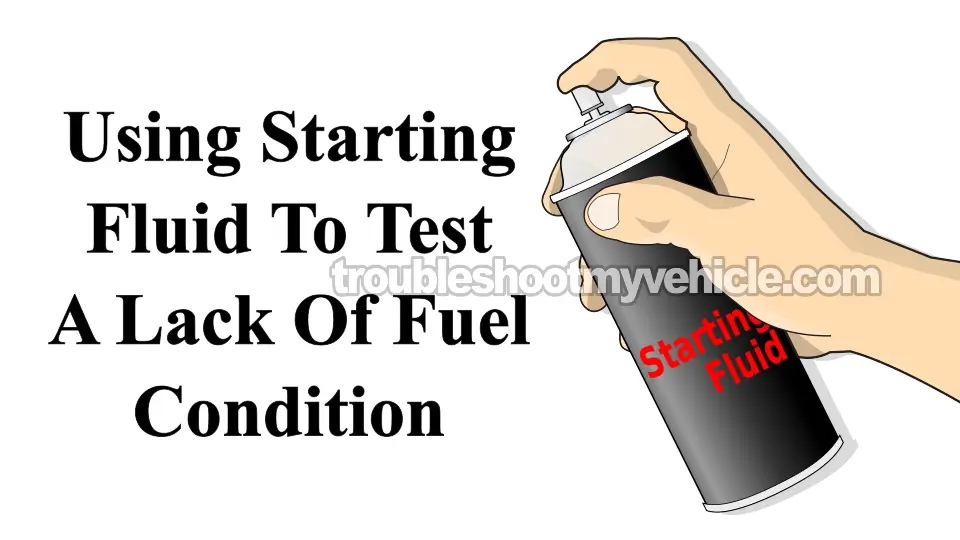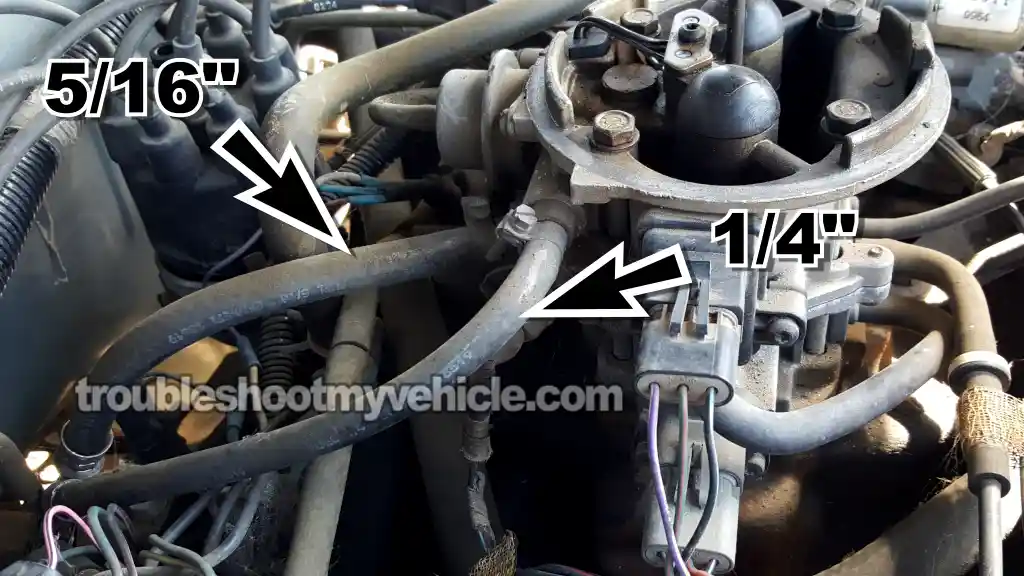
Testing the fuel pump, with a fuel pressure test gauge, on your 1989-1991 Dodge Ram TBI (throttle body injection) van is a pretty simple process.
I'll walk you through it, step-by-step. With your test results, you'll quickly find out if the fuel pump is working correctly or if it's completely shot.
I'm also gonna explain how you can use starting fluid to pinpoint an engine no-start problem to a fuel delivery problem.
NOTE: The 1989-1991 5.2L/5.9L V8 engines are equipped with a throttle body injection (TBI) fuel system.
Contents of this tutorial:
APPLIES TO: This tutorial applies to the following vehicles:
- Dodge Ram B150 Van 5.2L V8: 1989, 1990, 1991.
- Dodge Ram B250 Van 5.2L V8: 1989, 1990, 1991.
- Dodge Ram B250 Van 5.9L V8: 1989, 1990, 1991.
- Dodge Ram B350 Van 5.9L V8: 1989, 1990, 1991.
1992-2003 V8 Dodge Ram Van Fuel Pressure Test:
Fuel Pump Wiring Diagrams:
- Fuel Pump Circuit Wiring Diagram (1989 5.2L, 5.9L V8 Dodge Ram Van.
- Fuel Pump Circuit Wiring Diagram (1990-1991 5.2L, 5.9L V8 Dodge Ram Van).
Symptoms Of A Bad Fuel Pump
Fuel pumps usually quit in one of two ways:
- Total failure: The pump's dead, no fuel hits the injectors. You'll hear the engine crank, but it won't start.
- Weak output: The pump still runs, barely. It gives just enough fuel to start the engine, but not enough to keep it going when you place the transmission in Drive and step on the gas pedal.
If the pump's weak but not totally done, you might notice stuff like this:
- Rough idle: The engine feels shaky when idling —worse if it's in Drive.
- Hard start: You've got to crank the engine a long time before it finally starts.
- Lack of power: Put it in Drive and hit the gas, and the van just won't go like it should.
- Backfiring: You'll hear popping sounds coming from the intake manifold when you step on the gas. That's a result of the engine running lean due to the pump not being able to keep up.
- Lean condition: Not enough fuel skews the air/fuel mixture and can trigger oxygen sensor or fuel trim codes.
If your van cranks but won't start, or it runs bad, a fuel pressure test can quickly tell you if the pump's the problem.
What does "lean" mean? Your engine needs a precise air-to-fuel ratio —typically 14.7 parts air to 1 part fuel— for clean, efficient combustion. To keep that balance, the fuel injection computer constantly adjusts fuel delivery based on how much air flows into the engine.
If the fuel pump can't keep up and fuel delivery drops below what's needed, the mixture becomes lean —too much air, not enough fuel, leading to incomplete combustion and potential misfires.
On the flip side, when the engine receives more fuel than the incoming air can burn, the mixture is rich —excess fuel lowers combustion efficiency and can trigger higher emissions or foul the spark plugs.
Fuel Pressure Specifications
| 1989-1991 | |
|---|---|
| 5.2L, 5.9L V8 | 14.5 PSI (Throttle Body Injection -TBI- System) |
Where To Buy A Fuel Pressure Test Gauge
A fuel pressure test gauge is a must-have for any serious DIY mechanic and thankfully, you can buy them just about anywhere. If you don't already own one, it's definitely worth adding to your toolbox.
Here are a few good kits that will work with your TBI fuel injected V8 Dodge Ram Van:
Disclosure: As an Amazon Associate, I earn from qualifying purchases. If my tutorials help you, using these links is an easy way to support the site at no extra cost to you. Thank you!
TEST 1: Checking Fuel Pressure With A Fuel Pressure Gauge
Your throttle body's got two rubber fuel hoses connected to it. The bigger one —5/16"— sends pressurized fuel in. The smaller 1/4" hose returns leftover fuel through the return line (check image 2 of 2 above).
To run a fuel pressure test, we're gonna insert a pressure test adapter between that 5/16" hose and the throttle body's metal inlet port (see the illustration above).
You'll find the metal port down low at the rear of the throttle body —that's where the 5/16" hose goes. The smaller hose on top connects to the 1/4" return hose.
If your test kit's doesn't have the right adapter, check out my kit picks here: Where To Buy A Fuel Pressure Test Gauge.
Here's how we're gonna do this:
- 1
Pull the air cleaner assembly off the throttle body.
- 2
Pull the vacuum hose off the fuel pressure regulator.
- 3
Disable the ignition system. You don't want spark while testing.
NOTE: Disconnect one of the two wires at the ignition coil. Leave the distributor's 3-wire connected (this is important). - 4
Unplug the injectors' electrical connector. That way no fuel sprays out during testing.
- 5
Stick a shop rag under the fuel inlet hose.
It'll soak up any fuel that drips next. - 6
Disconnect the 5/16" fuel hose from the throttle body's inlet port.
NOTE: You've got two hoses —5/16" and 1/4". The thicker one —that's your supply line and the one that needs to be disconnected. - 7
Connect the adapter hose to the metal port, then connect the pressure gauge adapter to it.
- 8
Connect the 5/16" fuel hose you pulled off into the other end of the adapter.
- 9
Have someone switch the key ON and OFF a few times but don't crank the engine yet.
Watch the adapter and hoses for leaks. If it's dripping gasoline, tighten the clamps. - 10
Now crank the engine and keep your eye on the gauge.
NOTE: It shouldn't start since the injectors and ignition coil are both disabled. - 11
You wanna see about 14.5 PSI on the gauge.
Let's break down your test results:
CASE 1: Gauge shows 0 PSI. No fuel's reaching the injectors —that's why it won't start.
Most likely, your fuel pump's dead and needs a replacement. But check that it's getting 10 to 12 Volts DC while cranking. If it's not, the wiring or relay's probably the issue —not the pump.
CASE 2: There's pressure, but it's low. That means the pump's weak and needs to be replaced.
CASE 3: You see 14.5 PSI. This is the correct and expected test result and confirms the fuel pump is OK.
If the van still won't start (but fuel pressure's solid), then the pump's not the problem. Fuel's is reaching the injectors —something else is keeping that engine from starting.
TEST 2: Using Starting Fluid To Confirm Lack Of Fuel

If you're wondering why your van won't start and you think the fuel pump might be the problem, a quick way to check is with a starting fluid test.
It's a simple test —spray some starting fluid into the throttle body, then crank the engine. If it fires up for a few seconds, you've likely got a fuel delivery issue (probably a bad fuel pump).
This isn't the most precise way to diagnose a fuel pump, but it's a solid first step when you're tracking down a no-start problem.
NOTE: The starting fluid test only works if every spark plug wire's firing spark. If you haven't tested for spark yet, do that first.
IMPORTANT: After spraying, set the air cleaner lid back on the assembly before cranking the engine. No need to bolt it down —this quick step helps contain any backfire and keeps things safe.
Here's how to do the test:
- 1
Take the air cleaner lid off.
No need to yank the whole air cleaner assembly off of the throttle body —just its lid. - 2
Open the throttle and spray some starting fluid inside the throttle body.
- 3
Drop the lid back on the air cleaner right after spraying.
You don't have clamp it down —just as long as you place it back on. - 4
Crank the engine with the lid sitting in place.
- 5
You'll get one of two results:
1.) Engine starts, runs for a few seconds, then stalls.
2.) Engine cranks, but never fires up.
What do the results mean?
CASE 1: Your van's engine started, ran, then died. This confirms that a fuel issue is behind the engine not starting. It generally points to a bad fuel pump.
You still need to confirm it (a bad fuel pump) with a fuel pressure test: TEST 2: Checking Fuel Pressure With A Fuel Pressure Gauge.
CASE 2: Your van's engine didn't start at all. That means the issue's not fuel-related.
Still, this test isn't perfect. Even if nothing happens, it's smart to test fuel pressure the right way. Go here: TEST 2: Checking Fuel Pressure With A Fuel Pressure Gauge.
More 5.2L, 5.9L V8 Dodge Ram Van Tutorials
I've written quite a few 5.2L, 5.9L V8 Dodge Ram van 'how to' tutorials. You can find them in this index:
Here's a small sample of the articles/tutorials you'll find in the index:
- Throttle Body Temp Sensor Tests (1989-1991 5.2L, 5.9L V8 Dodge Ram Van).
- How To Test The MAP Sensor (1989-1990 5.2L, 5.9L V Dodge Ram Van).
- How To Test The MAP Sensor (1991 5.2L, 5.9L V8 Dodge Ram Van).
- How To Test For A Blown Head Gasket (1989-2003 5.2L, 5.9L V8 Dodge Ram Van).

If this info saved the day, buy me a beer!






